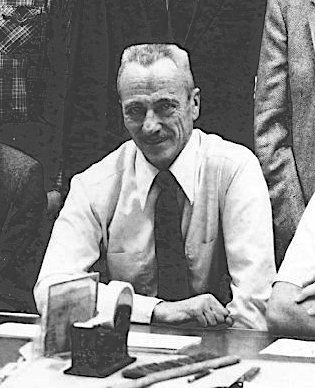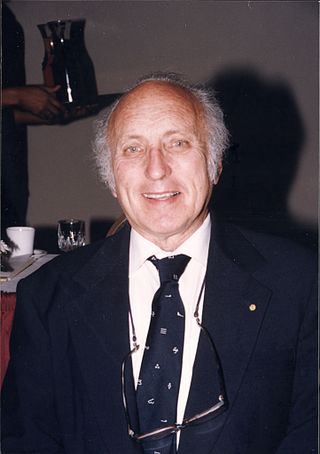
The National Weather Service (NWS) is an agency of the United States federal government that is tasked with providing weather forecasts, warnings of hazardous weather, and other weather-related products to organizations and the public for the purposes of protection, safety, and general information. It is a part of the National Oceanic and Atmospheric Administration (NOAA) branch of the Department of Commerce, and is headquartered in Silver Spring, Maryland, within the Washington metropolitan area. The agency was known as the United States Weather Bureau from 1890 until it adopted its current name in 1970.

Carl-Gustaf Arvid Rossby was a Swedish-born American meteorologist who first explained the large-scale motions of the atmosphere in terms of fluid mechanics. He identified and characterized both the jet stream and the long waves in the westerlies that were later named Rossby waves.
The University Corporation for Atmospheric Research (UCAR) is a US nonprofit consortium of more than 100 colleges and universities providing research and training in the atmospheric and related sciences. UCAR manages the National Center for Atmospheric Research (NCAR) and provides additional services to strengthen and support research and education through its community programs. Its headquarters, in Boulder, Colorado, include NCAR's Mesa Laboratory, designed by I.M. Pei.

The US National Center for Atmospheric Research is a US federally funded research and development center (FFRDC) managed by the nonprofit University Corporation for Atmospheric Research (UCAR) and funded by the National Science Foundation (NSF). NCAR has multiple facilities, including the I. M. Pei-designed Mesa Laboratory headquarters in Boulder, Colorado. Studies include meteorology, climate science, atmospheric chemistry, solar-terrestrial interactions, environmental and societal impacts.

The Weather Research and Forecasting (WRF) Model is a numerical weather prediction (NWP) system designed to serve both atmospheric research and operational forecasting needs. NWP refers to the simulation and prediction of the atmosphere with a computer model, and WRF is a set of software for this. WRF features two dynamical (computational) cores, a data assimilation system, and a software architecture allowing for parallel computation and system extensibility. The model serves a wide range of meteorological applications across scales ranging from meters to thousands of kilometers.

Joseph G. Galway, was an American meteorologist pioneering in the fields of severe convective storm forecasting and research. He was one of the first forecasters for the Severe Local Storms Unit and the National Severe Storms Forecast Center, and developed widely used synoptic predictors associated with severe thunderstorms and tornadoes, such as the jet streak and lifted index.
The NCEP/NCAR Reanalysis is an atmospheric reanalysis produced by the National Centers for Environmental Prediction (NCEP) and the National Center for Atmospheric Research (NCAR). It is a continually updated globally gridded data set that represents the state of the Earth's atmosphere, incorporating observations and numerical weather prediction (NWP) model output from 1948 to present.
Aksel C. Wiin-Nielsen was a Danish professor of meteorology at University of Copenhagen, University of Michigan, Director of the European Centre for Medium-Range Weather Forecasts (ECMWF), and Secretary-General of the World Meteorological Organization (WMO).

Dr. André Robert was a Canadian meteorologist who pioneered the modelling the Earth's atmospheric circulation.

The Verification of the Origins of Rotation in Tornadoes Experiment are field experiments that study tornadoes. VORTEX1 was the first time scientists completely researched the entire evolution of a tornado with an array of instrumentation, enabling a greater understanding of the processes involved with tornadogenesis. A violent tornado near Union City, Oklahoma was documented in its entirety by chasers of the Tornado Intercept Project (TIP) in 1973. Their visual observations led to advancement in understanding of tornado structure and life cycles.
An atmospheric reanalysis is a meteorological and climate data assimilation project which aims to assimilate historical atmospheric observational data spanning an extended period, using a single consistent assimilation scheme throughout.
Herbert Riehl was a German-born American meteorologist who is widely regarded as the father of tropical meteorology. He is well known for his work with Joanne Simpson on the importance of hot towers, and their critical role in transport of energy out of the tropics via the Hadley circulation. He was responsible for founding the atmospheric science department at Colorado State University.
Masao Kanamitsu was a Japanese and American atmospheric scientist working in the field of data assimilation. His research greatly influenced global and regional climate change studies including development of breakthrough reanalysis and downscaling datasets and weather forecasting studies. He was the co-author of one of the most cited geophysics paper in his time.
Richard B. (Ricky) Rood is a professor of Climate and Space Sciences and Engineering at the University of Michigan in Ann Arbor. Prior to 2005, he held several leadership positions at NASA’s Goddard Space Flight Center. He has more than 100 academic publications.
THORPEX is an international research programme established in 2003 by the World Meteorological Organization (WMO) to accelerate improvements in the utility and accuracy of weather forecasts up to two weeks ahead. It is part of the World Weather Research Programme and is a key component of the WMO Natural Disaster Reduction and Mitigation Programme.

Edwin Kessler III was an American atmospheric scientist who oversaw the development of Doppler weather radar and was the first director of the National Severe Storms Laboratory (NSSL).
Roland Aloysius Madden, an American meteorologist, was a staff scientist at the National Center for Atmospheric Research (NCAR) from 1967 to 2002. His research centers on diagnostic studies of the atmosphere. Madden is a fellow of the American Meteorological Society (AMS) and a recipient of the 2002 Jule G. Charney Award of the AMS.

Project NIMROD was a meteorological field study of severe thunderstorms and their damaging winds conducted by the National Center for Atmospheric Research (NCAR). It took place in the Greater Chicago area from May 15 to June 30, 1978. Data collected was from single cell thunderstorms as well as mesoscale convective systems, such as bow echoes. Using Doppler weather radars and damage clues on the ground, the team studied mesocyclones, downbursts and gust fronts. NIMROD was the first time that microbursts, very localized strong downdrafts under thunderstorms, were detected; this helped improve airport and public safety by the development of systems like the Terminal Doppler Weather Radar and the Low-level windshear alert system.
William Christopher Swinbank was a British-born meteorological physicist who worked at the UK Meteorological Office, the CSIRO Australia and the NCAR Colorado. His main areas of research were fog prediction, upper atmosphere analysis, wind predictions, hail storms and turbulent fluxes.









